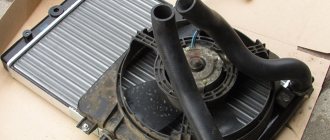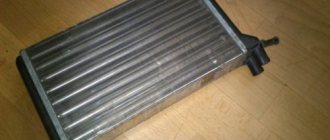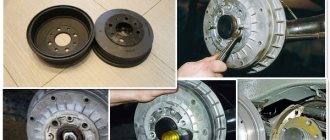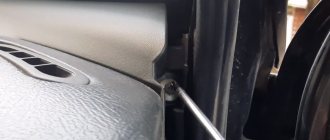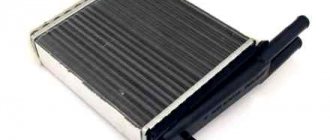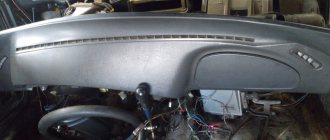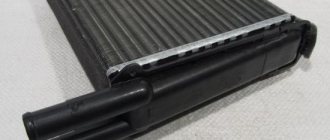Any modern car, including the VAZ 2114, has an interior heating system. In the cold season, it is very uncomfortable in a car without a stove, but, unfortunately, any vehicle tends to break down sooner or later. And if the heater does not work, you have to look for the cause of the breakdown.
Heater radiator
Choosing a heater radiator for a VAZ 2114
Which heater radiator is better for a VAZ 2114?
The question is more relevant than ever. All owners of the fourteenth understand that the heating system leaves much to be desired. Not only does the car not warm up enough (although in most cases it is difficult to do anything about the temperature regime in many regions), but the heater also tends to fail, antifreeze begins to leak, and so on. As a standard, especially on first-generation Samaras, VAZ used copper radiators. Relatively recently, a domestic manufacturer adopted foreign experience and began to use aluminum heaters. And yet, which is the best heater radiator for the VAZ 2114 still needs to be figured out.
Heater radiator VAZ 2114
Aluminum or Copper
Obvious advantages of an aluminum radiator:
- the presence of side ribs is much larger than that of a competitor
- the width of the channels for air flow is greater (this fact can significantly reduce the risk of breakage, and also increases the efficiency of heat supply at idle)
The obvious disadvantage of an aluminum radiator:
- heats up very quickly and cools down just as quickly (heat transfer is 209.3 W/m.deg)
- As soon as a leak is discovered, it needs to be replaced; such a unit cannot be resuscitated
Obvious advantages of a copper heater:
- heats up for a long time and cools down just as long (rather, the second part of the radiator’s property is a plus), heat transfer is 389.6 W/m.deg
- can be reanimated: as soon as a leak appears, you just need to solder the hole
Obvious disadvantages of a copper heater:
- fewer ribs than the competitor
- the channels are small and narrow, they tend to clog quickly, which impairs warming up and adds more reasons for repairs
- At idle it barely warms up.
- it is difficult to find a high-quality copper heater, since almost everyone who makes units from such material uses impurities and can paint the original material, which naturally reduces the heat transfer property
Today, aluminum radiators are clearly more popular than copper ones. And this is primarily due to the difficulty of finding a high-quality copper unit. And if luck smiles on you, then the price for a copper radiator of a VAZ 2114 stove will be many times higher than for an aluminum radiator. Average. You will get aluminum from 1000 rubles, and copper from 1700 rubles! This is still good, if you install it yourself, the radiator replacement service will cost 800-1000 rubles, on average. By the way, if you can’t solder a leaking copper heater on your own, then taking it to the service center every time will be very expensive; you’ll be able to save up for a limousine. And since all VAZ spare parts tend to be imperfect, keep in mind that you will have to deal with this one way or another. So think about whether it’s worth buying a copper radiator for the VAZ 2114 stove.
Specific examples
The painted copper radiator on the VAZ 2114 deserves special attention in the debate about which heater radiator is better, copper or aluminum. By the way, these are made by an office called “LUZAR”. There is no need to take such units: they are very cold, and have minimal heat transfer! But such devices have a full year warranty.
Why is everything so bad with Luzar? An autopsy will show: the rubber band, which is located next to the passage channels of the ribs, simply becomes damp after a relatively short period of time (less than a year) and the same short mileage. Another big disadvantage of Luzarov radiators is that the pipes are separated from each other, this reduces heat transfer, but makes the cost advantageous.
In general, it is now difficult to find a zero radiator that is relatively recent. Factory junk will crumble, radiators from the manufacturer are not always of decent quality. Therefore, the guideline you can choose is very simple (when choosing a radiator): it just has to be working and not clogged. And what material it is made of is the tenth thing.
Another company, DAAZ, has proven itself very well. There is only one minus - try to find it, and then try to find the original. By the way, the heat output of the Daazov heater is slightly lower than the factory one in the VAZ. And in terms of quality it clearly wins.
Another example is a heater from Oberkraft. The factory carefully approaches the testing process of the unit, which is why it is covered by a good warranty (one year). This device is made of aluminum alloy, which meets modern quality standards. An obvious advantage is the good, uniform distribution of heat throughout the cabin (apparently, they decided not to skimp on pipes), but considering the price, you can’t say that this is an easy purchase – from 1,800 rubles. But there are justifications for this price:
- Corrosion resistant
- Relatively light in weight
- Very important: resistant to temperature changes!
- Robust design
- Excellent and uniform heat dissipation.
In winter, even the highest quality stove will play tricks in terms of heat output. We offer a couple of good tips on how to make the interior warmer:
- You need to change the antifreeze and rinse the entire cooling system - this will remove all the debris in the tubes, making it easier for air to enter the cabin
- A great way to improve the microclimate is to install a new stove!
- You can also replace the cooling radiator with a new one - this will save the antifreeze from premature fatigue
- An option is to replace the pump, because it is responsible for the stability of coolant circulation at idle
- Run all the pipes and get rid of air pockets
As strange as it may sound, the stove can be insulated. Yes, for example, after running the entire system, you can glue all the joints, then the heat through the pipes will be precisely directed through the channels towards you, and not spread in an unknown direction. Another way: change the mode of air intake from outside to recirculation (why it is worth explaining this elementary action as one of the ways: yes, because many people think that the stove needs to be plugged! But the air intake does not come clearly from under the hood, which is what they are trying shut up, but just from outside!
So, as soon as such a crazy thought appears in your head, change the air intake mode). The last option for preserving heat is to insulate the interior itself. A very logical action, especially considering the presence of gaps around the body on the fourteenth.
Price and article
The table below shows several good manufacturers, the price of their products and the article number by which you can find and purchase this part.
| Manufacturer | vendor code | Price, (rubles) |
| DAAZ | 21082-1301012 | 2300 |
| Luzar | 21082-1301012U | 1655 |
| PRAMO | 21082-1301012 | 1310 |
| Hofer | HF708412 | 1300 |
Which stove radiator to choose: copper or aluminum
Many people ask the question: which stove radiator is better - copper or aluminum? There can be no definite answer here; each has its own disadvantages and advantages.
Operating principle of the heater
To make the right choice, you need to know the principle of operation of the heating system in a car.
Heat enters the car interior from the engine, this is a side effect of its operation. Heat is generated as a result of fuel combustion and from rubbing surfaces. To remove heat from very hot parts, the engine is equipped with a cooling system, an integral part of which is interior heating. Therefore, the hotter the engine gets, the better the heating. Hot coolant is supplied to the heater core, and the fan, passing air through it, dissipates heat throughout the cabin.
The temperature of the air leaving the deflectors is regulated by a tap located on the line between the motor and the stove. This is a regular shut-off valve with a mechanical or electrical drive; it regulates the amount of coolant that passes through the heater (by increasing the temperature on the control unit, the valve opens more; by decreasing the temperature, it closes). How the stove will work greatly depends on its operation. If it does not work correctly (does not fully open the passage for liquid), then it will be cold in the cabin.
Also an important factor is the temperature “overboard”; even a well-functioning heater in cold weather will heat a little worse, since the liquid does not heat up enough, because of this the heating becomes insufficient. The thermostat has a big influence: if it doesn’t work correctly, then don’t install any radiator, and cold air will blow from the deflectors. First you need to check the proper functioning of the entire system as a whole, and then think about replacement.
Device
The radiator of the heating system is similar to its older brother from the cooling system. And their functions are similar, only the large one releases heat into the atmosphere, and the small one into the cabin. Both have two tanks in their design, which are connected to each other by tubes. Plates are attached to the tubes by soldering, increasing the cooling area (the more plates, the greater the heat transfer). Therefore, when choosing, you need to pay special attention to the number of plates. This can be done by placing both copies together and visually inspecting the density of the plates. Which radiator has a higher density, the heat transfer is higher. Liquid inlet and outlet pipes are attached to one of the tanks. Some models are equipped with places for attaching to a car.
Copper stove radiator
- Copper has greater thermal conductivity than aluminum. And with an increase in thermal conductivity, heating improves.
- Maintainability. Copper is soft and will not be damaged by minor dents. Even if cracks appear, burst tubes can be soldered, leaving thermal conductivity unchanged.
- The copper radiator is equipped with a tank made of the same material, which significantly improves its performance characteristics.
Flaws
Aluminum radiator
- The first and most important advantage will be its price. It is almost two times smaller than that of its copper counterpart.
- With an increased number of plates (increased cooling area), the heat transfer will be less than that of copper, but not so significantly.
- Prevalence in the new car market. Cars of recent years produced in our country are equipped with aluminum radiators.
Flaws
- The low thermal conductivity of the material is the biggest disadvantage.
- Non-repairability: if the tubes are damaged, they cannot be soldered, and the entire assembly has to be replaced. A plastic tank can be damaged by the slightest blow. Some copies may have a crack in the tank out of the box. There are “craftsmen” who change tanks, but this is unreliable, and there is a high probability of failure of the entire stove.
- Susceptibility to corrosion. Aluminum is more susceptible to corrosion, which leads to poor heat transfer and the formation of smudges and failure of the entire interior heating system.
Summarizing all of the above, we can say that both types are clogged with dirt equally, both from the inside and the outside. And while it is possible to wash the outside of the device, doing it properly inside is problematic. And if the cooling system of your engine is clean (the engine has been overhauled or a new car has been done), then it is better to choose a copper option, if this is possible for your model. Well, if the condition of the water jacket is unknown, it is better to take an aluminum one and replace it after a few seasons with the same cheap option.
CHOICE
So which heater radiator is better, copper or aluminum for a VAZ 2114? Let's consider the disadvantages of each manufacturing material.
Copper or aluminum?
What can you say about the aluminum stove radiator? Aluminum has good thermal conductivity and therefore heats up quite quickly. True, it also cools down almost immediately. Therefore, when you turn off the engine, the cabin of the 2114 will become cold after a while.
A solid (or prefabricated) heat exchanger has plates as a heat exchanger, and inside them there are tubes through which coolant flows. The tanks on the part are plastic. This design is the cheapest, but the heat transfer is low. Such spare parts are products of a non-original manufacturer. In a non-assembled radiator, the heat-dissipating element is a corrugated tape. The tanks of the product are soldered and are often made of metal. But the soldering is factory-made, and it is very problematic to repair a leak in aluminum using a makeshift method.
Advantages of aluminum products:
- High thermal conductivity and, as a result, rapid heating;
- Relatively low price, especially for prefabricated structures;
- Sufficient width of outlet channels;
- Light weight and significant rigidity.
Good heating of the interior at any speed is provided by the original heater radiator, but car owners very often complain about non-original products. But lately, DAAZ products are not always available on the shelves of auto stores, and therefore VAZ 2108-2115 owners have to be content with what is available. The disadvantages of aluminum parts include:
- Insufficient service life;
- Low maintainability;
- When water is used for cooling, aluminum is susceptible to corrosion.
The type of manufacturing of a copper stove radiator is very similar to the aluminum type of non-prefabricated structure. Copper has good heat transfer, and therefore parts made from it better heat the surrounding space (do not confuse thermal conductivity with heat transfer - these are different concepts!). But everything is spoiled by the softness of the copper material - the outlet channels have to be made narrower and the distance between the tubes is greater. Tanks of such RP are reinforced with brass.
Advantages of a copper radiator:
- High heat transfer, heating is of better quality than aluminum, heat is retained longer;
- High maintainability, copper is easy to solder;
- Longer service life.
But copper parts still have more disadvantages, and nowadays copper radiators are considered structurally obsolete. Moreover, the plant does not produce original copper spare parts, and non-original versions have a lot of defects, and the quality is generally low.
- High cost, copper products are 30-100% more expensive than aluminum ones;
- Warm-up takes a long time, the interior of the car does not heat up immediately;
- At idle engine speeds, the interior of the car does not warm up well due to the narrow pipes:
- Poor workmanship.
The service life of an aluminum stove radiator is on average at least three years, while a copper heating system element is much more durable and can last for a decade. But is such an advantage necessary - the car can be changed more than once during this time.
Before replacing the heater radiator on a VAZ 2114, you need to weigh all the advantages and disadvantages of both types and make your choice. Lately, there have been fewer and fewer fans of copper stove heating systems; aluminum parts are more practical, and their low cost does not impact the pocket so noticeably.
Which heater radiator for the VAZ 2114 is better - copper or aluminum
Increasingly, motorists are wondering which heater radiator is better, copper or aluminum, for a VAZ 2114. This question is especially relevant in winter, especially if the car enthusiast lives in one of the northern regions of the country.
In addition, the issue is extremely important due to the fact that the standard car heating system is quite mediocre. The car warms up extremely slowly. As a result, the driver and passengers can freeze very quickly.
Important! Quite often the heater breaks down completely and the motorist needs to have it repaired. Sometimes there are smaller problems with the radiator (it may start leaking, etc.).
Previously, the VAZ company used only copper radiators, but recently the company decided to try using aluminum radiators. So which of these radiators is preferable to use on the VAZ 2114?
Which heater radiator to install on a VAZ 2114
Key advantages of aluminum radiators:
- A radiator made of aluminum will have significantly more side fins. This makes it more convenient and practical.
- The width of all channels in an aluminum radiator is much larger. It is because of this that you can increase the efficiency of supplying warm air at idle.
The main disadvantages of an aluminum radiator:
- The aluminum radiator heats up extremely quickly.
- It is almost impossible to restore an aluminum radiator that has even a small leak.
Key advantages of a copper radiator:
- The copper radiator on the VAZ 2114 heats up for a very long time. It also takes a long time to cool down.
- A radiator made of copper can be easily restored.
Copper radiator of the VAZ 2114 stove and its disadvantages:
- A small number of ribs.
- The channels are too narrow and small. They clog very quickly, which has the most negative effect on warming up. As a result, such a radiator has to be repaired quite often.
- There is practically no heating at idle.
- It is too difficult to find a sufficiently efficient copper radiator. Many of them are made from extremely low-quality material with many different impurities. The heat transfer of such devices is at the lowest level.
Today, aluminum radiators are much more popular than copper radiators. The reason for its popularity is that finding a high-quality copper radiator has recently become too difficult.
Another problem is that many models of copper radiators cost exorbitant amounts of money. Not every VAZ 2114 owner can afford to purchase such a unit. An aluminum radiator can cost almost 2 times less!
If we add to this the cost of replacing radiators at a service center, then in the end the car enthusiast’s wallet will become noticeably lighter. Not everyone will be able to replace this unit on their own, so it is worthwhile to include in the budget for replacing the radiator in advance the cost of specialist work.
Tools required for repairs
If you want to do the repairs yourself, you need to prepare the following tools:
- keys for 8 and 10;
- screwdrivers;
- heads for 8 and 10;
- pliers;
- container for draining antifreeze;
- jack;
- sealant;
- rags.
Independent work is completely justified, since as of March 24, 2019, the average price for replacing a cooling radiator for a VAZ 2114 and other models is 2.2 thousand rubles. Which will more than double costs.
The most common mistakes of those who choose a particular radiator model
Some car owners prefer units. It is not worth buying such devices. The fact is that they have practically no heat transfer! The warranty on units from this manufacturer is 12 months, but the efficiency of such radiators is practically zero.
Sometimes car enthusiasts prefer heaters from. These devices are quite efficient. Manufacturer's warranty - 1 year. These radiators help distribute heat evenly throughout the car's interior, but the cost of these units may seem overpriced.
Advice! Some car enthusiasts are faced with another problem. It turns out that even buying a fairly high-quality radiator may not give the expected result. In order for the stove to work effectively enough, you need to change the antifreeze in advance, and then rinse the cooling system of the machine. In a similar way, you can get rid of various debris in the tubes. This is extremely important, because only after this procedure the air entering the cabin will become cleaner.
We can also recommend replacing the pump. This unit is responsible for how coolant circulates in the car at idle.
Some experienced motorists also recommend getting rid of all air jams.
Let's summarize
In general, repairs are quite accessible for doing it yourself, but you need to immediately prepare for a significant time investment. Work can last for 2-6 hours. When replacing the radiator, it is necessary to change the coolant. Work with 8-valve and 16-valve engines is carried out in the same way. If the car has air conditioning, you will have to remove and install it during the repair, but not on all models. It is advisable to replace the bushings at the same time. The work is completed by checking the functionality of the engine and the condition of the coolant. Namely, whether it is boiling.
For greater clarity on replacing the VAZ 2115 injector cooling radiator, you can watch this video:
Source
So which heater radiator is better for a VAZ 2114
Before replacing the radiator, you need to compare all the advantages and disadvantages of heaters made from different materials. Only after this can a final decision be made. It is worth taking into account the opinions of experts in this field. Many of them believe that aluminum parts are much more practical.
You should not buy painted radiators. This is a fairly common mistake made by many young car enthusiasts. The problem with painted radiators is that they have fairly low heat transfer.
In addition, they cause unpleasant odors in the car interior. Let's hope that the answer to the question of which radiator is better, aluminum or copper for the VAZ 2114, has now been found.
Which is better?
Of course, it is best to choose radiators of proven brands or original LADA spare parts. As a rule, such spare parts are not cheap and not everyone is ready to pay a tidy sum for a radiator when you can buy the same part, a little worse in quality, but several times cheaper.
Everyone knows firsthand that copper radiators are much better than aluminum ones, but this statement is closer to stove radiators, since copper radiators actually have greater heat transfer than aluminum ones. In a cooling radiator, this will not play a big role, so you don’t have to overpay for a copper cooling radiator and feel free to buy an aluminum one.
Choosing a heater radiator for VAZ 2114, 2113, 2115
Which radiator to choose for the stove on a VAZ 2114? This question is gaining relevance in connection with the approaching winter. It's no secret that not all domestically produced cars have a good heater. Let's try to figure out which radiator to choose:
Copper radiator.
Immediately after purchase, the copper radiator has a heat output of 389.6 W/(m. deg). The properties of copper are such that such a radiator takes a long time to heat up and takes a long time to cool down. The number of fins in a copper radiator is smaller than in an aluminum one, and the cross-section of the channels is smaller. Therefore, they clog faster and the stove blows cool air at idle. Most often, this is what VAZ owners complain about.
The advantages of a copper heater radiator include its maintainability. This is where the advantages end. And the disadvantages begin: recently, manufacturers have been saving on raw materials and using impure copper. Some paint radiators to give them a marketable appearance, but this reduces the heat transfer of such a radiator. Lately it has been very difficult to find a high-quality copper radiator.
Aluminum radiator.
The heat output of the aluminum radiator is 209.3 W/(m deg). This radiator heats up quickly and cools down quickly. The number of fins in an aluminum radiator is much greater than in a copper one, which is a definite plus. The cross-section of channels in an aluminum radiator is also larger than that of a copper radiator. Thanks to this, they do not clog longer and have greater heat transfer.
The disadvantages of an aluminum radiator include its non-repairability in case of leakage.
So which radiator should you buy?
Just a few years ago, the answer to this question would have been: copper. But time passes and today it is difficult to find a high-quality copper radiator. Therefore, our choice at the moment: aluminum.
However, we do not recommend buying painted radiators, because... their heat transfer is lower and an unpleasant odor may appear in the cabin.
Of the companies, we do not recommend buying heater radiators manufactured by Luzar. There are too many negative reviews about them.
How to prepare the VAZ 2114-15-13 stove for winter.
In order to avoid problems with the interior heater in winter, we recommend doing the following:
- Replace the coolant and flush the entire cooling system.
- Replace the interior heater radiator with a new one.
- Replace the engine cooling radiator with a new one
- Change the pump.
- Remove air from the cooling system.
These steps will help you avoid heat problems in the winter. Replacing radiators will help avoid contamination of the coolant, and replacing the pump will guarantee its normal circulation in the system.
Recommendations
Comments 244
But not Luzar is complete rubbish. The choice was between Luzar and DAAZ, Luzar foolishly took it, it doesn’t really warm anything up. Sometimes I freeze, I advise everyone to put on the DAAZ and it will be Tashkent...
and the difference between Luzar and DAAZ? no! I have it and it heats just like a potbelly stove! This is the third winter I've been driving in just a T-shirt))) KICK THE TERRIBLE AIR OUT OF THE SYSTEM
I installed Luzar two weeks ago, it heats up perfectly, before that it was also installed on another car
Heat? Does it heat up in all positions?
for everyone and even inflated it’s not bad
I installed a copper Orenburg one. I regret it, I will change it to DAAZ.
I installed a copper Orenburg one. I regret it, I will change it to DAAZ.
It doesn't heat up until you re-solder it. I installed the Daaz, everything is cool, it’s hot in the car.
It costs luzar. It heats normally and does not leak. About six months.
Review for luzar counted
I have already decided for myself that the DaAZ radiator is 100% better. It contains turbolizers or simply plastic spirals in all channels. The efficiency is very high. Luzar just completely sucks, I don’t advise you to waste your money anyway, it doesn’t heat up and in addition the stove gives off an unpleasant smell. I bought Daaz from us for 900 rubles.
Review for DAAZ thank you
The experiment has been carried out, but requires repeating. I mean, I drilled a 3 mm hole and then plugged it with a press washer on an elastic band and sealant. I’ll say right away that the cooling started almost immediately, but as it was cool at idle, it kept going. At the same time, the copper additional heater FRIES, and this is at a cool temperature. and. 40 and above. Next, I plugged the air flows into the legs back and forth with foam rubber, the air went to the windshield, warm. But the system also warmed up to almost 70 degrees... And for the purity of the experiment, I need to buy an undrilled one from Dimitrovgrad, I think maybe the tubes are overgrown on the inside? Although when I raised the speed to 2000, it started to blow warmer. But add. The heater at this time generally produces Sugar at noon. I'll go and have a look. Fortunately, winter is ahead, so let's evaluate the results in January.
On the road, due to lack of choice, I installed a “Luzar” heater radiator. Upon arrival home I replaced it with DAAZ. I'll explain it popularly. With the “Luzar” at 90 degrees on the engine, heat transfer occurred as with the DAAZ at 55-60 degrees. How many radiators have clients had to change, and this is what I observed when opening the side covers: the Luzars do not have those twisted “pastas” that DAAZ has in all sections, the function of which is not to drive liquid away, but to slow down to heat the radiator. Maybe at “Luzar” they learned to make for people, and not for quantity, but alas, so far I am disappointed with their products. I won’t say anything about copper, because we have such liquids that they completely corrode plastic.
Review for DAAZ counted
On the road, due to lack of choice, I installed a “Luzar” heater radiator. Upon arrival home I replaced it with DAAZ. I'll explain it popularly. With the “Luzar” at 90 degrees on the engine, heat transfer occurred as with the DAAZ at 55-60 degrees. How many radiators have clients had to change, and this is what I observed when opening the side covers: the Luzars do not have those twisted “pastas” that DAAZ has in all sections, the function of which is not to drive liquid away, but to slow down to heat the radiator. Maybe at “Luzar” they learned to make for people, and not for quantity, but alas, so far I am disappointed with their products. I won’t say anything about copper, because we have such liquids that they completely corrode plastic.
I've been driving with copper for 3 years. warms well for the south. antifreeze red AGA. doesn't corrode anything. but the color has not lost in 3 years - thermonuclear red. As one at the service station remarked, “Why did you kill someone else.” I won’t say how the previous radiator warmed up (most likely DAAZ) - it leaked in the summer
I just forgot that we also need to take into account the climate where the car is operated. Slavik792, who opened the topic with the question, is in the climatic zone where in winter there are rains and frosts down to -40. If you go down a couple of latitudes from you, then you can close the discussion - in the UAE, cars are supplied and manufactured without interior heating AT ALL.
copper heats great, only if it is a modern remake, it swells a little under pressure


